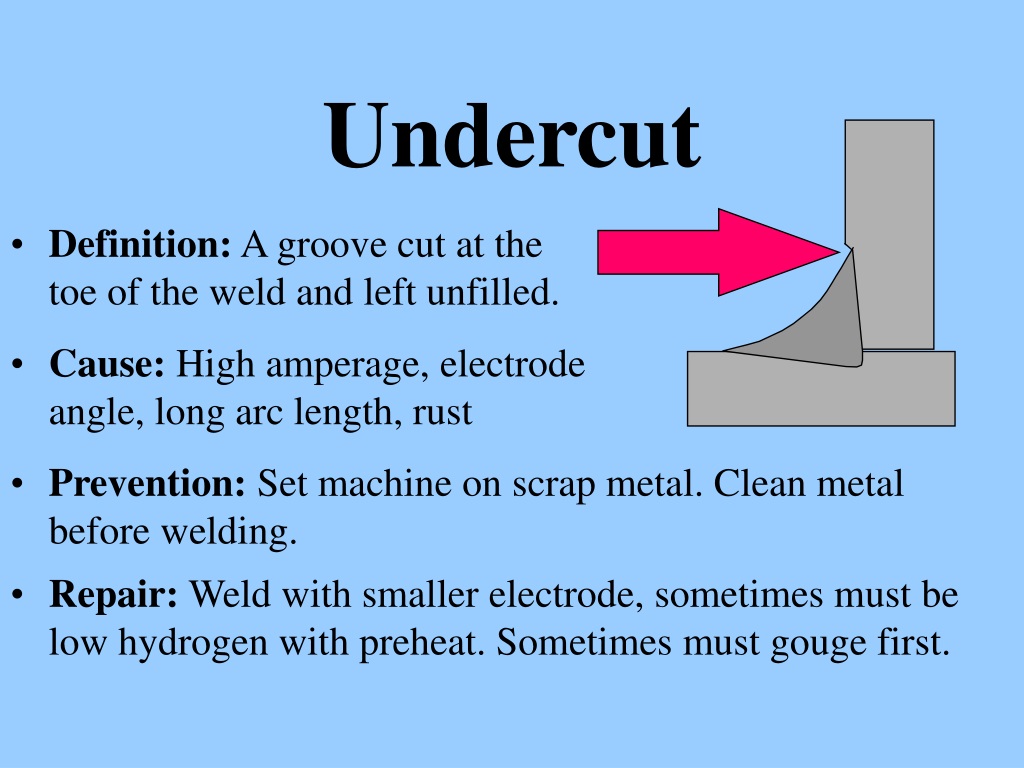A Comprehensive Overview to Identifying, Fighting, and Mending Undercut Welding Troubles in Your Welding Jobs
In the world of welding, experiencing undercut issues is a typical challenge that can compromise the structural stability and total top quality of your welding tasks. Recognizing the source behind undercut welding, having the ability to accurately identify it in your welds, and executing reliable preventative procedures are vital abilities for any type of welder. Additionally, having the knowledge and techniques to remedy undercut problems when they do happen can make a considerable difference in the last result of your welding undertakings. Stay tuned as we check out the crucial elements of recognizing, avoiding, and taking care of undercut welding problems, providing you with beneficial understandings and approaches to raise your welding skills to the next degree.
Common Reasons of Undercut Welding
Undercut welding, an usual concern in welding processes, can be created by various factors that need to be meticulously recognized and addressed to make certain the integrity of the weld joint. One of the primary causes of undercut welding is extreme warmth input.
One more common cause of undercut welding is incorrect welding strategy. Recognizing these root triggers and implementing rehabilitative measures is necessary in avoiding and remedying undercut welding problems in welding projects.
Identifying Undercut in Welds

To recognize undercut properly, appropriate lights and magnification devices are essential to evaluate the weld joint completely. Making use of tools such as a welding gauge or a magnifying glass can assist in discovering also the smallest undercut blemishes. Additionally, running a finger or a fingernail along the weld joint can often disclose undercut, as the surface may really feel irregular or have a dip where the undercut exists.
Safety Nets for Undercut
Having a deep understanding of the reasons of undercut in welds permits for the execution of efficient safety nets to keep weld high quality and stability. One important precautionary action appertains weld joint prep work. Ensuring that the edges are clean, without pollutants, and correctly beveled can significantly lower the chance of undercut (Preventing weld undercut). In addition, selecting the appropriate welding specifications, such as voltage, present, and travel speed, is essential. These setups should be enhanced to stop excessive warmth input, which can bring about undercut development.

Techniques for Fixing Undercut

Enhancing the welding current or lowering the travel speed can aid fill up in the undercut. Additionally, changing the welding method from a press to a drag or vice versa can likewise aid decrease undercut.
An additional method is to make use of a weaving activity while welding to guarantee appropriate sidewall fusion and fill in the undercut. By oscillating the welding arc back and forth within the weld joint, the welder can deposit a lot more filler material right into the undercut areas, properly getting rid of the problem.
Furthermore, grinding out the undercut and rewelding the joint can be a feasible solution for extra Read Full Report extreme undercut issues - Preventing weld undercut. This process entails getting rid of the undercut section, preparing the base steel, and afterwards rewelding the joint with correct welding parameters and methods to avoid undercut from reoccurring

Specialist Tips for Preventing Undercut
Using proper welding techniques and maintaining control over essential welding parameters are critical approaches for welders aiming to prevent undercut in their weld joints. In addition, choosing the proper welding procedure and filler steel for the details application can aid avoid undercut. Maintaining a consistent traveling rate throughout the welding process is another important pointer to stop undercut.
Verdict
Finally, identifying, preventing, and repairing undercut welding issues in your welding jobs is critical for making sure sturdy and strong welds. Preventing weld undercut. By understanding the typical reasons for undercut, having the ability to determine it in welds, executing safety nets, and making use of appropriate strategies for fixing undercut, you can prevent potential issues and develop top quality welds. Adhering to professional ideas for avoiding undercut can aid you improve your welding skills and produce better outcomes in your jobs
Undercut welding, a typical issue in welding processes, can be created by numerous elements that require to be thoroughly identified and resolved to guarantee the stability of the weld joint. Furthermore, running a finger or a fingernail along the weld joint can sometimes reveal undercut, as the surface area might feel uneven or have a dip where the undercut exists.
Making use of appropriate welding techniques and preserving control over vital welding specifications are important approaches for welders aiming to stop undercut in their weld joints.In conclusion, identifying, avoiding, and taking care of undercut welding troubles in your welding tasks is important for making certain strong and sturdy welds. By recognizing the Recommended Reading common reasons of undercut, being able to determine it in welds, implementing preventative steps, and making use of correct techniques for repairing undercut, you can avoid possible concerns and produce high-quality welds.